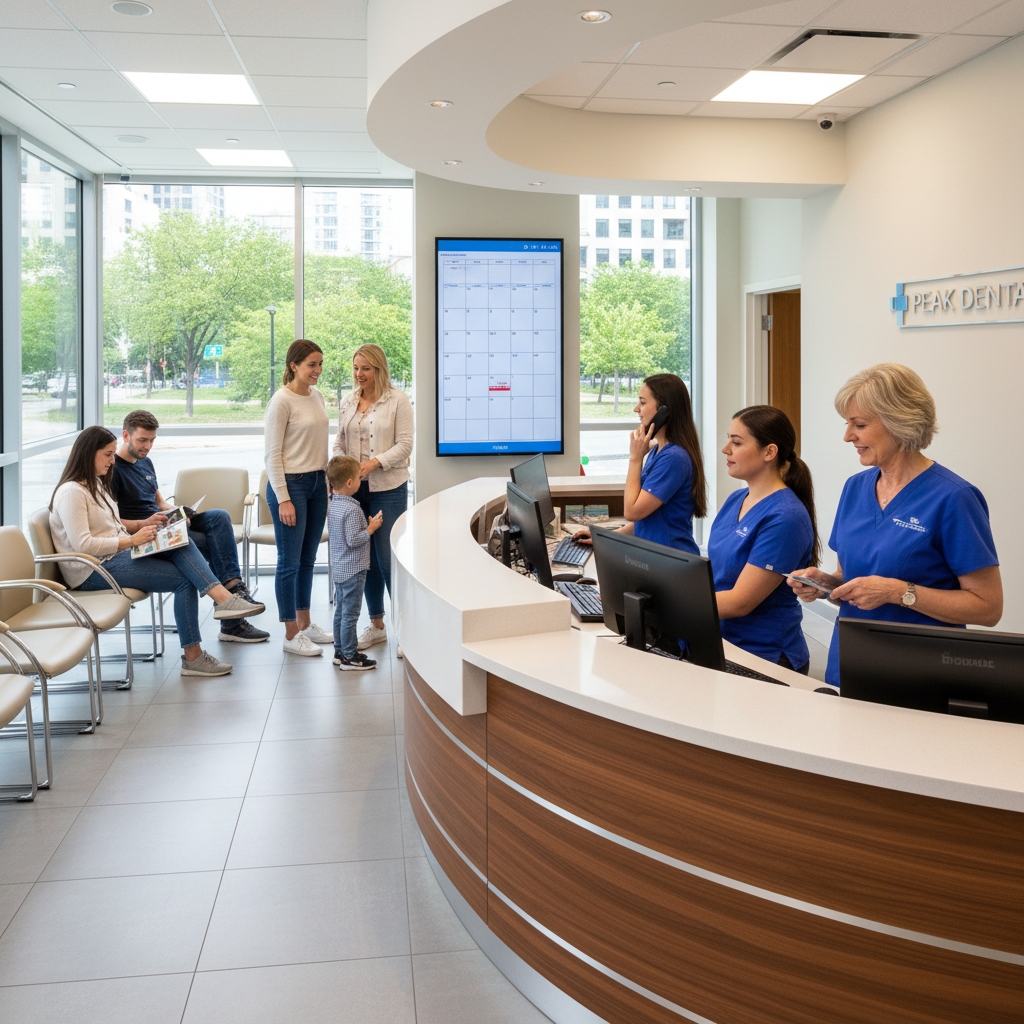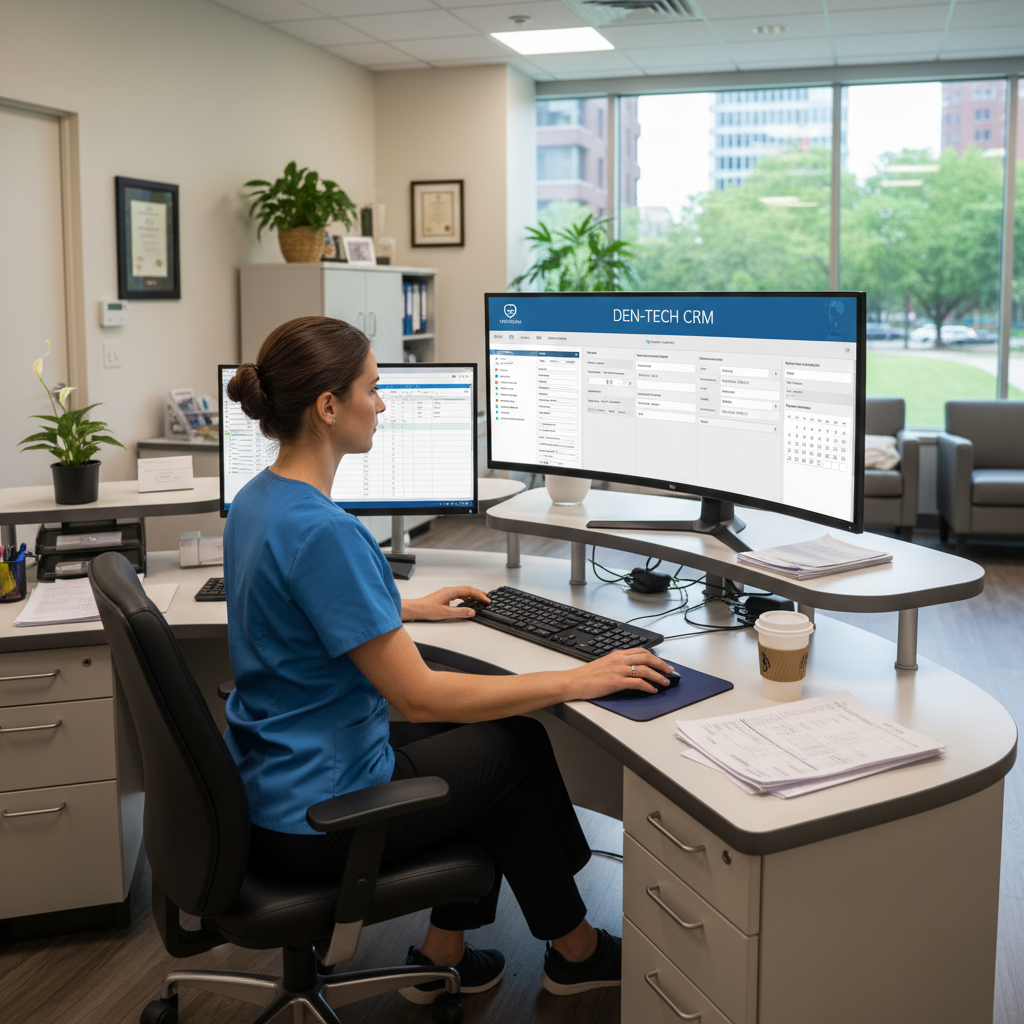












Blog Article


How to Offer White-Glove Setup for AI Implementation in Dentistry - Guide For Dentists and DSOs
Dental practices across the United States are rapidly adopting artificial intelligence to improve patient care and streamline operations. Nearly one-fifth of dental offices worldwide use AI-driven platforms as of 2024, with the AI dental imaging market expected to grow from $417.5 million to $3.83 billion by 2031.
White-glove AI implementation provides dentists and DSOs with comprehensive setup services, training, and ongoing support to ensure seamless technology integration without disrupting daily operations. This full-service approach eliminates the technical complexity that often prevents dental practices from successfully adopting AI tools for diagnostics, patient communication, and practice management.
The difference between successful AI adoption and failed implementations lies in proper setup, staff training, and continuous optimization. Practices that receive professional guidance during AI deployment see faster returns on investment and higher staff satisfaction compared to those attempting self-implementation.
Key Takeaways
- White-glove AI setup eliminates technical barriers and ensures smooth implementation for dental practices
- Professional implementation services include staff training, system integration, and ongoing support for optimal results
- Proper AI deployment with expert guidance delivers measurable improvements in patient care and operational efficiency
AI in Dentistry: White-Glove Setup Essentials
A successful AI rollout requires careful planning of implementation phases, proper technology integration, and comprehensive team preparation. These three pillars ensure smooth adoption and maximum ROI for dental practices and DSOs.
AI Implementation Process for Dental Practices
The implementation begins with a thorough assessment of current dental practice management workflows and technology infrastructure. Practices must evaluate their existing software systems, hardware capabilities, and data storage solutions.
Phase 1: System Assessment and Planning
- Audit current technology stack and identify integration points
- Map patient communication workflows and call handling processes
- Determine data migration requirements and compliance needs
Phase 2: Technical Setup and Configuration
- Install AI software and configure practice-specific parameters
- Integrate with existing practice management systems
- Set up call routing, scheduling protocols, and patient data access
Phase 3: Testing and Optimization
- Conduct thorough testing with sample scenarios and patient interactions
- Fine-tune AI responses based on practice specialties and protocols
- Validate data synchronization between systems
The entire process typically takes 2-4 weeks depending on practice complexity. DSOs often benefit from standardized deployment templates that can be customized for individual locations while maintaining brand consistency across the organization.
Key Components for Seamless AI Rollout
Technology integration forms the backbone of successful AI deployment in dental practices. The core components include robust internet connectivity, compatible practice management software, and secure data handling protocols.
Essential Infrastructure Requirements:
- High-speed internet with redundancy (minimum 25 Mbps upload/download)
- Cloud-based phone systems with API integration capabilities
- HIPAA-compliant data storage and transmission protocols
- Regular automated backups and disaster recovery plans
Integration Checkpoints:
Component Requirement Timeline
Phone System VoIP with API access Week 1
Practice Management Open integration capabilities Week 1-2
Internet Infrastructure Dedicated business line Pre-deployment
Security Protocols HIPAA compliance validation Week 2
The AI system must seamlessly connect with existing scheduling software, patient records, and billing systems. This integration allows for real-time appointment booking, patient verification, and automatic data updates across all platforms.
Staff Training and Onboarding for AI Receptionist
Staff preparation ensures smooth transition and optimal utilization of dental AI capabilities. Training focuses on system oversight, patient interaction protocols, and troubleshooting procedures.
Training Module Breakdown:
- Day 1-2: AI system overview and basic functionality
- Day 3-4: Patient interaction monitoring and intervention protocols
- Day 5: Advanced features and customization options
Staff members learn to monitor AI conversations, identify situations requiring human intervention, and manage system settings. They receive training on handling escalated calls, updating patient information, and generating reports.
Key Training Areas:
- Real-time conversation monitoring and quality control
- System configuration for different call types and scenarios
- Patient privacy protocols and HIPAA compliance procedures
- Backup procedures for system downtime or technical issues
The training includes hands-on practice with actual patient scenarios and role-playing exercises. Staff members become proficient in managing AI oversight while focusing on higher-value patient care activities during regular office hours.
Optimizing Patient Communication With AI Agents
AI voice agents can handle up to 70% of incoming calls while maintaining patient satisfaction rates above 90%. These systems provide round-the-clock availability, reduce appointment no-shows, and deliver personalized messaging that strengthens patient relationships.
24x7 Virtual Receptionist Benefits for Dental Practices
Virtual receptionists powered by AI eliminate the limitations of traditional business hours for dental practices. Patients can schedule appointments, request prescription refills, and receive answers to common questions at any time of day.
AI voice agents in healthcare demonstrate significant improvements in accessibility. A 12-physician practice reported 89% patient approval after implementing round-the-clock booking capabilities.
Key advantages include:
- Instant response times - No more 15-minute hold times during peak hours
- Multilingual support - Serves diverse patient populations in multiple languages
- Consistent service quality - Every interaction follows established protocols
Night and weekend availability captures appointment requests when patients have time to call. This timing often coincides with when motivation for dental care is highest.
The technology integrates seamlessly with existing phone systems and practice management software. Staff members can focus on complex patient needs while AI handles routine inquiries and scheduling tasks.
Reducing Missed Calls and No-Shows in Dental Clinics
Missed calls directly impact revenue and patient retention for dental practices. AI-powered communication tools help bridge care gaps by ensuring every patient inquiry receives immediate attention.
Call management improvements:
Metric Before AI After AI Implementation
Average wait time 15+ minutes Under 30 seconds
Call deflection rate 0% Up to 70%
Patient satisfaction Variable 90%+ consistently
Automated appointment confirmations and reminders significantly reduce no-show rates. The system sends personalized messages via phone, text, or email based on patient preferences.
Real-time rescheduling capabilities allow patients to modify appointments without speaking to staff. This flexibility accommodates last-minute changes that would otherwise result in missed appointments.
The AI tracks patient communication patterns and identifies optimal timing for outreach. Some patients respond better to morning reminders while others prefer evening contact.
Human-Tone Auto-Texting and Patient Engagement
Modern AI systems deliver text messages that sound natural and personalized rather than robotic. This approach maintains the personal touch patients expect from their dental practice.
The technology analyzes patient history, treatment plans, and communication preferences to craft relevant messages. Post-appointment follow-ups can include specific care instructions based on the procedures performed.
Engagement strategies include:
- Pre-appointment preparation reminders with specific instructions
- Post-treatment care guidance tailored to procedures
- Preventive care scheduling based on individual treatment timelines
- Insurance benefit reminders before year-end deadlines
Automated messaging maintains consistent patient communication without overwhelming staff workloads. The system can handle routine follow-ups while flagging urgent responses for immediate staff attention.
Two-way communication capabilities allow patients to ask questions and receive instant responses. This accessibility strengthens the patient-provider relationship and reduces anxiety about upcoming treatments.
Patient communication frequency and content can be customized for different practice segments. New patients might receive more educational content while established patients get focused appointment reminders.
Appointment Booking and Schedule Automation
AI-powered appointment systems integrate directly with dental practice management systems to handle patient scheduling without human intervention. These systems use smart chatbots and automated workflows to reduce front-desk workload while maintaining accurate appointment books.
Context-Aware Chatbots for Dental Appointments
Context-aware chatbots understand specific dental terminology and appointment types when patients request scheduling. These systems differentiate between routine cleanings, emergency visits, and specialized procedures like root canals or orthodontic consultations.
The chatbots ask relevant questions based on the appointment type. For cleanings, they verify insurance coverage and recall status. For emergency calls, they assess pain levels and urgency to prioritize scheduling appropriately.
Advanced chatbots recognize returning patients and access their treatment history. They can suggest appropriate follow-up appointments based on previous procedures and recommend optimal timing for preventive care.
Key capabilities include:
- Treatment-specific questioning protocols
- Insurance verification during booking
- Emergency triage and priority scheduling
- Patient history integration for personalized responses
These systems handle multiple conversation channels simultaneously. Patients can book through website chat, text messaging, or phone calls using the same AI system.
Automated Scheduling Directly Into PMS
Automated appointment booking systems connect directly to dental practice management systems without requiring manual data entry. The integration eliminates double-booking errors and maintains real-time schedule accuracy across all platforms.
The system checks provider availability, room assignments, and equipment requirements before confirming appointments. For complex procedures requiring specific operatories or extended time blocks, the AI considers these constraints automatically.
Integration features:
- Real-time calendar synchronization
- Provider-specific scheduling rules
- Equipment and room availability checking
- Automatic patient record updates
Most dental practice management systems support API connections for seamless data flow. The AI system updates patient records, sends confirmation messages, and creates necessary alerts for staff preparation.
Appointment modifications and cancellations process automatically through the same integration. The system immediately releases time slots and can offer them to waitlisted patients within minutes.
Reducing Manual Work for Front-Desk Teams
White glove implementation services ensure front-desk teams transition smoothly to automated scheduling workflows. Staff members focus on patient care and complex scheduling scenarios while AI handles routine booking requests.
The automation reduces phone interruptions during patient check-ins and treatments. Front-desk teams can concentrate on insurance processing, treatment planning coordination, and patient education without constant scheduling interruptions.
Workflow improvements:
- 24/7 booking availability eliminates after-hours call volume
- Automatic confirmation calls reduce no-show rates
- Waitlist management fills cancelled appointments instantly
- Insurance pre-verification streamlines check-in processes
Staff training focuses on managing exceptions and handling complex scheduling requests that require human judgment. The AI escalates situations involving multiple providers, insurance complications, or special accommodations to trained team members.
Performance metrics show front-desk productivity improvements of 30-40% when routine scheduling moves to automated systems. Teams report higher job satisfaction when freed from repetitive booking tasks.
Leveraging Analytics Dashboards in Dental Operations
Modern dental practices generate massive amounts of operational data that can drive significant improvements in patient care and revenue generation. AI-powered analytics dashboards transform raw practice data into actionable insights, enabling dentists and DSOs to identify missed opportunities, track staff performance, and optimize revenue streams through real-time monitoring systems.
Missed-Call Heatmaps for Dental Clinics
Missed calls represent one of the largest revenue leaks in dental practices. Analytics dashboards create visual heatmaps that show exactly when calls go unanswered throughout the day.
These heatmaps reveal patterns like high call volumes during lunch breaks or staff meetings. Practices can identify peak calling times and adjust staffing schedules accordingly.
Key metrics tracked include:
- Call volume by hour and day
- Response time averages
- Abandoned call percentages
- Caller retry patterns
The data helps practices determine optimal staffing levels for different time periods. Many practices discover they miss 20-30% of incoming calls during predictable windows.
DSOs benefit from comparing missed-call patterns across multiple locations. This analysis reveals which practices need additional front desk support or different scheduling protocols.
Dashboards can trigger automated alerts when missed calls exceed predetermined thresholds. This enables immediate corrective action rather than discovering problems weeks later through manual reporting.
Revenue Attribution and Production Recovery
Revenue attribution dashboards track how different marketing channels and referral sources contribute to actual treatment revenue. This goes beyond simple appointment bookings to measure completed treatments and payment collection.
The system connects initial patient inquiries to final treatment outcomes. Practices can see which marketing investments generate the highest-value patients and longest retention rates.
Production recovery tracking focuses on:
- Incomplete treatment plans
- Scheduled but uncompleted procedures
- Payment plan defaults
- Insurance claim delays
Data analytics tools for dental practices help identify patients who started treatment sequences but never completed them. These represent immediate revenue recovery opportunities.
Clinical decision support features highlight patients overdue for hygiene visits or recommended follow-up treatments. Automated workflows can trigger outreach campaigns to these patients.
DSOs use attribution data to optimize marketing budgets across locations. They can redirect spending from low-performing channels to those generating higher-value patient acquisitions.
Staff Follow-Up Tracking via Advanced Analytics
Staff follow-up tracking measures how effectively team members complete assigned patient outreach tasks. Analytics dashboards monitor call completion rates, email response times, and appointment conversion success.
Individual staff performance metrics include follow-up task completion percentages and patient response rates. This data helps identify training needs and top-performing team members.
Advanced tracking capabilities monitor:
- Treatment plan presentation follow-ups
- Insurance verification completion times
- Post-appointment satisfaction surveys
- Recall appointment scheduling success
The system tracks which staff members achieve the highest treatment acceptance rates during follow-up calls. These insights help practices replicate successful communication approaches across the entire team.
Automated workflow triggers ensure no patient falls through follow-up cracks. When staff members don't complete assigned tasks within specified timeframes, supervisors receive immediate notifications.
DSOs can benchmark follow-up performance across locations and identify best practices for systemwide implementation. This standardization improves patient experience consistency while maximizing revenue potential.
Integrating White-Label Solutions and Multi-Location Support
Dental practices implementing AI solutions require seamless integration across multiple locations while maintaining consistent branding. White-label integration experiences provide customized functionality that matches existing practice management systems without revealing third-party platforms.
Custom Integrations for Dental Support Organizations
DSOs need AI implementations that connect directly with their existing practice management software and patient communication systems. Custom API integrations allow AI tools to access patient schedules, update appointment statuses, and sync with billing platforms automatically.
Most dental AI platforms offer pre-built connectors for popular systems like Dentrix, Eaglesoft, and Open Dental. These integrations eliminate manual data entry and reduce staff training time.
Key integration requirements include:
- Real-time appointment synchronization
- Patient record access permissions
- Automated insurance verification workflows
- Billing system connectivity
Custom integrations also enable DSOs to maintain their preferred workflows while adding AI capabilities. The integration process typically takes 2-4 weeks depending on system complexity.
Multi-Location Rollouts for DSOs
Large dental service organizations require phased deployment strategies that minimize disruption across their practice network. Successful multi-location AI rollouts start with pilot programs at 2-3 locations before expanding systemwide.
Phased rollout timeline:
Phase Duration Locations Focus
Pilot 4-6 weeks 2-3 sites Testing and refinement
Regional 8-10 weeks 25% of locations Staff training
Full deployment 12-16 weeks All locations Performance optimization
DSOs benefit from centralized management dashboards that monitor AI performance across all locations. These systems track call handling rates, appointment booking success, and patient satisfaction scores.
Integrating white-label services allows DSOs to maintain operational consistency while scaling AI implementation efficiently. Regional managers can access location-specific data while corporate leadership views aggregate performance metrics.
White-Label Branding Options for Dental Practices
Dental practices want AI solutions that appear as natural extensions of their existing patient communication systems. White-label branding ensures patients interact with technology that reflects the practice's visual identity and communication style.
Customizable branding elements include:
- Voice characteristics - Accent, tone, and speaking pace
- Greeting scripts - Practice-specific welcome messages
- Hold music - Custom audio that matches office atmosphere
- Transfer protocols - Seamless handoffs to specific staff members
Advanced white-label solutions allow practices to customize AI responses for different patient types. New patients receive detailed directions and preparation instructions, while established patients get streamlined appointment confirmations.
The branding customization process typically requires 1-2 weeks for initial setup. Practices can adjust messaging and voice characteristics as needed without technical support.
Delivering Tangible Impact: Key Metrics for Success
Successful AI implementation in dental practices requires measuring specific outcomes that directly impact practice profitability and patient experience. The three critical metrics focus on revenue recovery, operational efficiency, and patient satisfaction improvements.
Revenue Recapture by Answering Missed Calls
Dental practices lose significant revenue when calls go unanswered during busy periods or after hours. Studies show that 27% of potential new patient calls are never answered, representing thousands in lost revenue monthly.
AI phone systems capture these missed opportunities by answering every call instantly. A typical dental practice with 50 new patient inquiries monthly can recover $15,000-$25,000 in lost revenue by eliminating missed calls.
Key metrics to track:
- Call answer rate: Should increase to 98-100%
- New patient conversion rate: Typically improves by 15-20%
- After-hours appointment bookings: Previously impossible revenue stream
- Monthly revenue from recovered calls: Track dollar amounts directly
DSOs benefit significantly from this metric across multiple locations. Each practice location that implements AI to scale white-glove customer success can multiply revenue recovery results organization-wide.
Calculate your practice's missed call revenue by multiplying unanswered calls by average new patient value.
Decrease in Manual Staff Workload
AI implementation should measurably reduce time staff spend on repetitive administrative tasks. Front desk staff typically spend 60-70% of their time answering phones and scheduling appointments.
Workload reduction metrics include:
- Phone handling time: Reduce by 40-60% per staff member
- Appointment scheduling errors: Decrease by 80-90%
- Staff overtime hours: Monitor monthly reduction
- Time spent on appointment confirmations: Nearly eliminate manual calls
Track these improvements weekly during the first month, then monthly ongoing. Staff can redirect saved time toward patient care, insurance verification, and treatment coordination tasks that require human expertise.
Document specific time savings per staff member. For example, if a receptionist previously spent 4 hours daily on phone calls, AI should reduce this to 1.5-2 hours maximum.
Measuring Patient Satisfaction Post-AI Implementation
Patient satisfaction scores provide crucial feedback on AI system performance and overall practice experience. Modern patients expect immediate responses and 24/7 availability that AI systems deliver.
Essential satisfaction metrics:
- Response time satisfaction: Measure patient feedback on call answer speed
- Appointment booking ease: Track completion rates and user experience scores
- Overall practice communication rating: Monitor monthly patient surveys
- Patient retention rates: Compare pre and post-AI implementation
Survey patients monthly using simple 1-10 rating scales. Focus questions on communication speed, booking convenience, and overall experience quality.
Patient complaints about phone service should decrease dramatically within 30 days of implementation. Measuring success through key metrics and KPIs for AI initiatives ensures practices achieve intended improvements.
Track new patient referrals as an indirect satisfaction metric. Satisfied patients refer more frequently, indicating successful AI integration.
Resonate's White-Glove Approach for Dental AI Adoption
Resonate offers dental practices a comprehensive AI solution that handles 30% of missed calls through automated patient engagement. The platform combines three specialized AI agents with complete setup and optimization support for dentists and DSOs.
AI-Native Patient Engagement for Dentists and DSOs
Resonate addresses a critical gap in dental practice operations where 30% of dental practice calls go unanswered. The platform automatically responds to missed calls with personalized text messages that maintain a human-like tone.
The AI system activates immediately when calls go to voicemail. It sends empathetic messages to potential patients within seconds of their missed call.
Key engagement features include:
- Instant response: Messages sent within 30 seconds of missed calls
- 24/7 availability: Continuous patient communication outside office hours
- Appointment booking: Direct scheduling through text conversations
- Multi-location support: Centralized management for DSOs with multiple practices
The platform recognizes that 78% of patients book appointments with the first practice that responds. This creates urgency for dental practices to maintain consistent patient communication.
Three Powerful AI Agents: Receptionist, Chatbot, Analytics
Resonate deploys three specialized AI components that work together to maximize patient conversion rates. Each agent handles specific aspects of patient interaction and practice management.
The AI Receptionist manages incoming calls and immediately follows up with missed callers. It maintains conversation context and schedules appointments directly into practice management systems.
The AI Chatbot continues conversations through multiple touchpoints. It answers common questions about services, insurance, and availability while maintaining HIPAA compliance.
Analytics AI tracks performance metrics including:
- Response times to missed calls
- Conversion rates from inquiry to appointment
- Patient engagement patterns
- ROI measurements for dental practices
These agents integrate with existing dental software systems. They require no changes to current workflows or staff training protocols.
Core Pain Points Addressed for Dental Practices
Dental practices face specific challenges that Resonate's AI implementation directly solves through targeted automation and patient engagement strategies.
Lost revenue recovery represents the primary benefit for dental practices. The platform converts missed calls into scheduled appointments that would otherwise result in lost patients to competitors.
Staff efficiency improvements allow front desk teams to focus on in-office patients rather than constant phone management. The AI handles initial patient screening and appointment scheduling automatically.
Patient experience enhancement occurs through immediate responses and 24/7 availability. Patients receive consistent communication regardless of office hours or staff availability.
The white-glove support approach includes complete system setup and ongoing optimization. Dental practices receive dedicated support teams that monitor performance and adjust AI responses based on practice-specific needs.
DSOs benefit from centralized management across multiple locations with standardized patient engagement protocols. The system provides comprehensive reporting for network-wide performance tracking and AI implementation frameworks compliance.
Frequently Asked Questions
Dental practices considering AI implementation often have specific questions about setup processes, regulatory requirements, and operational impacts. These common concerns address everything from initial integration steps to long-term compliance considerations.
What does white-glove setup entail for AI implementation in dental practices?
White-glove setup provides comprehensive hands-on assistance for deploying AI systems in dental practices. The service includes initial consultation, custom configuration, staff training, and ongoing support to ensure smooth implementation.
White-glove implementation services typically begin with a detailed assessment of the practice's current technology infrastructure. Technical specialists evaluate existing practice management systems, network capabilities, and workflow requirements.
The setup process includes installing AI software, configuring integrations with existing dental software, and customizing features for specific practice needs. Staff receive comprehensive training on system operation, patient interaction protocols, and troubleshooting procedures.
Testing phases verify all systems function correctly before going live. The implementation team monitors initial operations and provides immediate support to address any issues that arise during the transition period.
What key considerations should dentists have when integrating AI into their practice workflows?
Practice management system compatibility represents the most critical consideration for AI integration. Dentists must verify that AI solutions can seamlessly connect with their existing scheduling, billing, and patient record systems.
Staff training requirements vary significantly between different AI implementations. Simple AI receptionists may require minimal training, while diagnostic AI tools need extensive education on interpretation and clinical application.
Patient data security becomes paramount when introducing AI systems. Practices must ensure AI vendors comply with HIPAA regulations and maintain appropriate data encryption and storage protocols.
Cost-benefit analysis should include both initial setup expenses and ongoing subscription fees. Integrating AI receptionist systems can capture missed revenue opportunities while reducing administrative overhead.
Workflow disruption during implementation can affect patient care and staff productivity. Practices should plan implementation during slower periods and maintain backup systems during transition phases.
Can you outline the step-by-step process of implementing AI technology in a dental setting?
The implementation process begins with comprehensive needs assessment and technology evaluation. Practices identify specific pain points, workflow inefficiencies, and areas where AI can provide measurable improvements.
Vendor selection follows detailed comparison of features, pricing, integration capabilities, and support services. Practices should request demonstrations and speak with existing dental clients before making decisions.
Pre-implementation preparation includes staff meetings, timeline establishment, and backup system activation. IT infrastructure assessment ensures adequate bandwidth, hardware compatibility, and security measures.
Installation and configuration typically take 1-2 business days depending on system complexity. Technical teams handle software deployment, integration testing, and initial customization based on practice requirements.
Staff training occurs in phases, starting with administrators and gradually including all team members. Training covers system operation, patient interaction protocols, troubleshooting, and escalation procedures.
Go-live monitoring involves close supervision during initial weeks of operation. Implementation teams track system performance, address issues immediately, and make adjustments based on real-world usage patterns.
What are the common challenges faced during the AI adoption process in dentistry, and how can they be mitigated?
Staff resistance often emerges as the primary challenge during AI adoption. Team members may fear job displacement or feel overwhelmed by new technology requirements.
Mitigation strategies include transparent communication about AI's role in enhancing rather than replacing human capabilities. Providing comprehensive training and highlighting how AI reduces mundane tasks while allowing focus on patient care helps build acceptance.
Technical integration problems frequently occur with older practice management systems. Legacy software may lack modern APIs necessary for seamless AI connectivity.
Practices can address integration challenges by working with vendors who specialize in dental technology and offer custom integration solutions. Upgrading core practice management systems may be necessary for optimal AI performance.
Patient acceptance varies, with some patients preferring human interaction for all communications. Clear communication about AI capabilities and maintaining options for human interaction addresses these concerns.
Cost justification becomes challenging when ROI timelines extend beyond immediate implementation periods. Tracking metrics like reduced no-shows, improved scheduling efficiency, and decreased staff overtime helps demonstrate value over time.
How does AI improve patient care and operational efficiency in dental practices?
AI enhances patient care through 24/7 availability for appointment scheduling, insurance verification, and basic inquiries. Patients can schedule appointments outside business hours without waiting for office staff availability.
Automated appointment reminders and confirmation systems reduce no-show rates by 20-30% in typical dental practices. AI systems can send personalized reminders via text, email, or phone calls based on patient preferences.
Operational efficiency improves through automated routine tasks like insurance eligibility verification and pre-appointment preparation. Staff can focus on complex patient needs rather than repetitive administrative duties.
AI diagnostic tools assist dentists in identifying conditions earlier and more accurately. Image analysis AI can detect cavities, periodontal disease, and other conditions that might be missed during routine examinations.
Revenue optimization occurs through better appointment scheduling algorithms that minimize gaps and maximize chair utilization. AI systems can automatically fill cancellations and optimize schedule density based on procedure types.
What should dentists know about the regulatory and compliance aspects of using AI in dentistry?
HIPAA compliance remains the fundamental requirement for any AI system handling patient information. Dentists must verify that AI vendors maintain proper data encryption, access controls, and audit trails for all patient interactions.
Business Associate Agreements (BAAs) are mandatory for all AI vendors processing protected health information. These agreements establish legal responsibility for data protection and outline procedures for breach notification.
FDA oversight applies to AI systems used for diagnostic purposes or clinical decision support. Dentists should verify that diagnostic AI tools have appropriate FDA clearance or approval before implementation.
State dental board regulations may impose additional requirements for AI use in clinical settings. Some states require specific disclosures to patients when AI assists in diagnosis or treatment planning.
Data retention policies must align with both federal regulations and state requirements. Practices need clear procedures for data storage duration, deletion processes, and patient access to AI-processed information.
Professional liability insurance may require updates to cover AI-assisted diagnosis and treatment decisions. Dentists should consult with insurance providers about coverage implications before implementing clinical AI tools.
Similar Articles
Ready to Get Started
Have Questions?
We're Here to Help
Connect with our team for personalized guidance
No setup fees, cancel anytime.
.avif)


.svg)
.svg)





